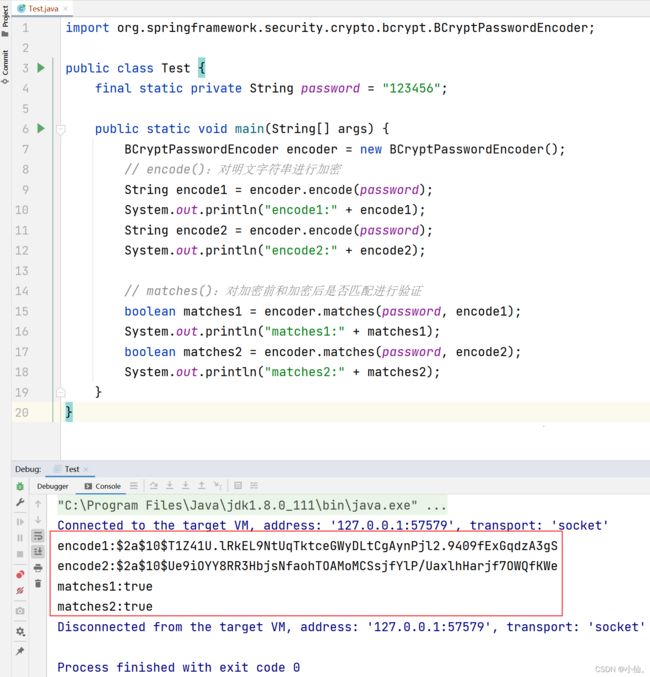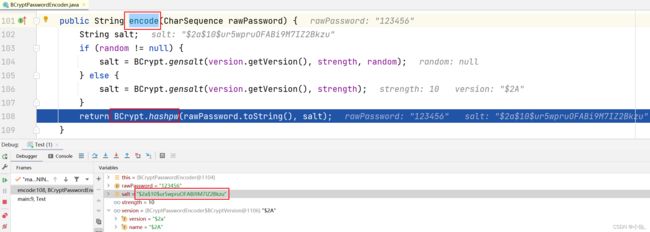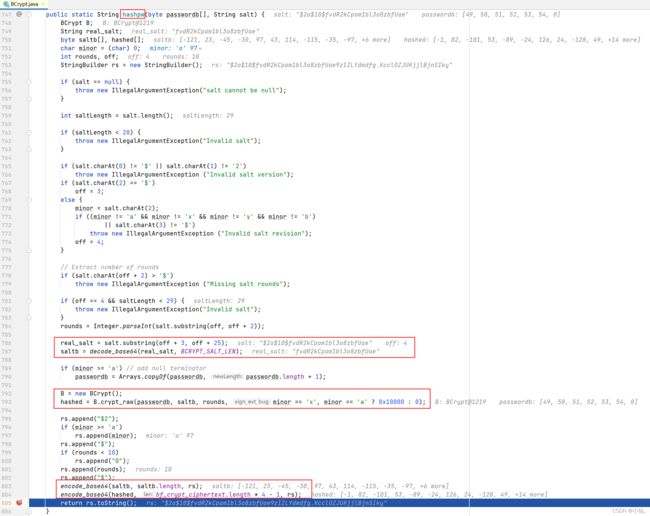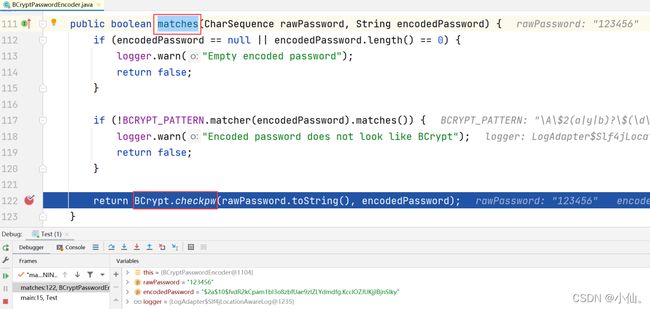- JMH基准测试入门:科学测量Java代码性能的艺术
zhysunny
Java类库java开发语言
目录一、为什么需要JMH?二、快速入门:你的第一个基准测试1.添加JMH依赖2.编写测试类3.运行并查看结果三、JMH核心概念详解1.测试模式(@BenchmarkMode)2.状态管理(@State)3.预热与测量(@Warmup&@Measurement)四、进阶技巧:解决真实问题案例1:HashMap初始容量优化案例2:流(Stream)vs传统循环五、避免JMH测试的常见陷阱1.死代码消除
- FeignClient客户端调用入门
超龄超能程序猿
javaspring
在分布式微服务架构广泛应用的技术背景下,服务间通信机制的设计与实现已成为系统开发的核心环节。Feign作为一种基于声明式编程范式的HTTP客户端框架,通过标准化的接口定义与注解配置,显著降低了Web服务调用的开发复杂度,有效提升了微服务间的交互效率。在SpringCloud技术栈体系中,Feign客户端功能的实现主要依托于@FeignClient注解,该注解通过整合Spring框架的依赖注入与动态
- (LeetCode)Java 求解最长回文子串
南淮北安
冲刺大厂之Java刷题笔记leetcode字符串动态规划java算法
文章目录一、题解二、常规理解三、简单理解四、总结一、题解给定一个字符串s,找到s中最长的回文子串。你可以假设s的最大长度为1000。示例1:输入:“babad”输出:“bab”注意:“aba”也是一个有效答案。示例2:输入:“cbbd”输出:“bb”二、常规理解思路就是创建一个二维数组,boolean[][]flag,flag[i][j]表示字符串第i到j是否是回文。边界:字符串长度为1是为TRU
- 深入解析Redis 7.0中每种数据类型的底层实现
添砖Java中
redis数据库缓存
一、String(字符串)核心实现:SDS(SimpleDynamicString)structsdshdr{uint64_tlen;//已使用长度(O(1)获取长度)uint64_talloc;//总分配空间(不含header)unsignedcharflags;//类型标识(SDS_TYPE_8/16/32/64)charbuf[];//柔性数组(实际数据)};Java视角特性:二进制安全:可
- 取余和取模到底是不是一回事?对比Python、Java、C和C++中的%运算符
霜叶桑
javapythonc语言c++
取余和取模到底是不是一回事?对比Python、JAVA、C和C++中的%运算符数学中的「取余」和「取模」计算机领域中的「取余」和「取模」Python、Java、C和C++中的`%`运算符Python:取模运算Java:取余运算C和C++:取余运算为什么一般用正除数数学中的「取余」和「取模」在纯数学中,当我们谈论整数除法a÷ba\divba÷b(aaa是被除数,bbb是除数,且b≠0b\not=0
- 帮我仔细讲解一下注解中设置值,这值是如何被注解修饰的类利用到的?介绍具体内部逻辑
小花鱼2025
java开发语言
这个问题非常好,涉及到了Java注解的运行机制,特别是:注解中的参数是怎么设置的,又是怎么在运行时被类/方法/字段使用到的?我将从定义→编译期→运行期→实际用途这4个方面,深入剖析Java注解内部逻辑。✅一、注解定义&设置参数我们先自定义一个注解,并使用它://1.定义注解@Retention(RetentionPolicy.RUNTIME)//关键:允许运行时反射获取@Target(Elemen
- JavaScript与原生开发的较量:为何高性能可视化应用更适合选用SciChart?
界面开发小八哥
javascript开发语言SciChart图表工具数据可视化
SciChart是高性能数据可视化领域的优秀图表产品,深受数据密度和精度至关重要行业的信赖,包括航空航天、石油和天然气、科学研究和赛车运动等。作为F1中使用的解决方案,SciChart被NASA所依赖,并受到90%的顶级医疗技术公司青睐,它提供实时、跨平台的可视化,提供无与伦比的灵活性和定制性。立即获取SciChart正式版在为iOS和Android打造高性能数据可视化应用时,选择合适的开发方式至
- 2025年- H93-Lc201-- 64.最小路径和(多维动态规划)--Java版
豆包版:每天进步一点点
javaleetcode动态规划java算法
1.题目描述2.思路(1)dp含义:dp[i][j]以i-1的word1字符串和j-1的word2字符串的最少操作次数。(2)递推公式:1)word1[i-1]和word2[j-1]相等的情况此时的字符串是不需要操作,i-2和j-2的操作次数与(i-1和j-1)的操作次数相等dp[i][j]=dp[i-1][j-1]2)word1[i-1]和word2[i-1]不相等的情况删除和添加是互逆的,操作
- JavaScript浅拷贝与深拷贝
旺代
JavaScript前端javascript开发语言
目录浅拷贝(ShallowCopy)一、浅拷贝的定义二、直接赋值vs浅拷贝1.直接赋值2.浅拷贝三、数组的浅拷贝方法1.slice()2.concat()3.扩展运算符(...)四、对象的浅拷贝方法1.Object.assign()2.扩展运算符(...)五、浅拷贝的局限性六、总结深拷贝(DeepCopy)一、深拷贝的定义二、深拷贝的常见实现方式1.JSON.parse(JSON.stringif
- 2025年- H90-Lc198-- 1143. 最长公共子序列(多维动态规划)--Java版
1.题目描述2.思路每个格子dp[i][j]都表示:从字符串开头开始,分别取前i个字符和前j个字符之间的最优子结构(最长公共子序列的长度)最终的dp[m][n]表示的就是:“从头到尾整个text1和text2的最长公共子序列长度”。答:不需要,因为我们构造dp[i][j]的时候,就是按“从左上到右下”的顺序,逐步比较两个字符串的公共子序列长度。3.代码实现classSolution{publici
- Java 数据类型详解:从初学者到理解底层原理
超浪的晨
java合集开发语言java后端
作为一名Java开发工程师,你可能已经对数据类型有了一定的了解。但无论你是刚入门的新手,还是想系统回顾基础知识的老手,这篇文章都将帮助你全面、深入地掌握Java中的数据类型。一、什么是数据类型?在Java中,数据类型(DataType)决定了变量可以存储什么类型的数据,以及该变量占用多少内存空间。Java是一种静态类型语言,也就是说,在声明变量时必须指定其数据类型。Java的数据类型可以分为两大类
- springcloud feign调用get请求变成了post请求解决
只想要搞钱
springcloudjavaspring
1.feign调用get请求,feignService定义的get请求的参数是一个对象,如下图,调用另一个服务时,提示405,变成了post请求@GetMapping("/trainContact/queryContactForCurrentUser")Result>queryContactForCurrentUser(TrainContactPageDTOpageDTO);2.解决,对象前加一个
- feign调用get请求的接口时,出现“Request method ‘POST‘ not supported“
皮皮小澜孩
java开发语言feign
上面是错误的写法下面是正确的写法其实就是在feign接口的参数中加了个@SpringQueryMap注解@SpringQueryMap是微服务之间调用,使用openfeign通过GET请求方式来处理通过实体类来传参情况的注解。注意:被@SpringQueryMap注解的对象只能有一个如果需要传递多个对象,可以使用map传参,并且多个对象中不能出现相同的属性名,否则会覆盖
- 微服务: Feign调用GET请求找不到请求体实体类
pingzhuyan
#SpringCloud微服务#异常总结分类javaSpringCloudfeignGet实体类
目录彩蛋:里面传递了token使用过滤器可以实现自动传递token无需传递,下一篇介绍1.方法一:尽可能使用post请求把GET改成POST,把方法上参数实体类加上@RequstBodY,这是最快速得方案2.方式二:依然使用get请求需要使用feign新加的请求参数->@SpringQueryMap注解2.1添加的位置:2.2写一个配置类注入feignBuilder方法(重点)2.3源码剖析Bea
- 学生选课系统(11457)
codercode2022
visualstudiocodespringboot开发语言matlabjavalaravelobjective-c
有需要的同学,源代码和配套文档领取,加文章最下方的名片哦一、项目演示项目演示视频二、资料介绍完整源代码(前后端源代码+SQL脚本)配套文档(LW+PPT+开题报告)远程调试控屏包运行三、技术介绍Java语言SSM框架SpringBoot框架Vue框架JSP页面Mysql数据库IDEA/Eclipse开发有需要的同学,源代码和配套文档领取,加文章最下方的名片哦!
- 介绍electron
几道之旅
electronjavascript前端
一、Electron是什么?Electron是一个基于Chromium和Node.js的框架,允许开发者使用前端技术(HTML/CSS/JavaScript)构建原生桌面应用。其核心优势在于:跨平台:一次开发,生成Windows、macOS、Linux三端应用;技术栈统一:前端开发者无需学习新语言,直接复用Web生态(如Vue/React);混合架构:Chromium:负责渲染界面,支持现代CSS
- Unity反射机制
future1412
unity游戏引擎
反射知识点回顾编译器是一种翻译程序它用于将源语言程序翻译为目标语言程序源语言程序:某种程序设计语言写成的,比如C#、C、C++、Java等语言写的程序目标语言程序:二进制数表示的伪机器代码写的程序知识点一什么是程序集程序集是经由编译器编译得到的,供进一步编译执行的那个中间产物在WINDOWS系统中,它一般表现为后缀为·dll(库文件)或者是·exe(可执行文件)的格式说人话:程序集就是我们写的一个
- \SpringBootDemo-1.0-SNAPSHOT.jar中没有主清单属性
郭宝
JavaEE#SpringBootjarmavenjava
背景:java-jar.\SpringBootDemo-1.0-SNAPSHOT.jar--spring.profiles.active=dev在运行打包以后的maven项目时,出现了如下报错信息解决办法:1、需要在项目根目录下的pom.xml文件中添加SpringBoot构建的插件org.springframework.bootspring-boot-maven-pluginrepackage<
- spring-ai-alibaba 1.0.0.2 学习(十二)——聊天记忆扩展包
学习spring-ai时提到过,spring-ai除了内置的InMemoryChatMemoryRepository,还提供jdbc、cassandra、neo4j三个扩展包。而spring-ai-alibaba则提供了jdbc、redis、elasticsearch三个扩展包。两者都提供了jdbc扩展包,有什么区别呢?spring-aijdbc和spring-ai-alibabajdbc对比sp
- Java学习第十七部分——Mocking 框架
慕y274
java学习开发语言
目录一.概述1.Mockito2.PowerMock3.EasyMock4.JMockit5.WireMock二.选择一.概述在Java开发中,Mocking框架是单元测试的重要工具,用于模拟外部依赖,从而隔离被测试代码与外部系统之间的交互。以下介绍几种流行的JavaMocking框架:1.MockitoMockito是目前最流行的JavaMocking框架之一,具有以下特点:-**简洁的API*
- Java学习第三部分——面向对象基础
慕y274
java学习开发语言
目录一.简介二.类和对象(一)类(Class)(二)对象(Object)三.构造方法(Constructor)四.封装(Encapsulation)五.继承(Inheritance)六.多态(Polymorphism)(一)方法重载(MethodOverloading)(二)方法覆盖(MethodOverriding)七.抽象类和接口(一)抽象类(AbstractClass)(二)接口(Inter
- 介绍Flutter
一、Flutter的核心优势:不止于跨平台高性能原生渲染自研引擎Skia:直接调用GPU绘制UI,绕过原生控件依赖,消除JavaScript桥接性能损耗,实现60fps流畅动画。三棵树渲染机制(Widget-Element-RenderObject):通过差异化更新最小化重绘范围,效率远超传统WebView方案。极速开发体验热重载(HotReload):代码修改后毫秒级生效,保留应用状态调试,开发
- LinkedList数据结构链表
辞暮尔尔-烟火年年
集合数据结构链表
LinkedList在Java中是一个实现了List和Deque接口的双向链表。它允许我们在列表的两端添加或删除元素,同时也支持在列表中间插入或移除元素。在分析LinkedList之前,需要理解链表这种数据结构:链表:链表是一种动态数据结构,由一系列节点组成,每个节点包含数据部分和指向列表中下一个节点的引用。双向链表:每个节点都有两个链接,一个指向前一个节点,另一个指向后一个节点。LinkedLi
- 【性能优化与架构调优(一)】Java 应用性能优化
Java应用性能优化:从JVM到并发编程的全方位解析一、JVM调优:打造高性能运行环境1.1JVM内存模型与核心参数配置JVM内存结构主要包含堆(Heap)、栈(Stack)、方法区(MethodArea)、本地方法栈(NativeMethodStack)和程序计数器(PCRegister)。其中,堆是GC的主要区域,可通过以下参数进行调优:#JVM启动参数示例(以生产环境常用配置为例)java-
- Redis+Caffeine双层缓存策略对比与实践指南
浅沫云归
后端技术栈小结RedisCaffeine缓存
Redis+Caffeine双层缓存策略对比与实践指南在高并发场景下,缓存是提升系统性能和并发处理能力的关键手段。常见的缓存方案包括远程缓存(如Redis)和本地缓存(如Caffeine)。单层缓存各有优劣,结合两者优势的双层缓存架构已成为生产环境中的最佳实践。本文将基于SpringBoot,从方案对比分析出发,深入探讨Redis、本地Caffeine与双层缓存的实现与性能差异,并给出选型建议与实
- Kotlin 安装使用教程
小奇JAVA面试
安装使用教程kotlin开发语言android
一、Kotlin简介Kotlin是JetBrains开发的一种现代、静态类型的编程语言,完全兼容Java,主要应用于Android开发、后端服务开发、前端Web开发(Kotlin/JS)和多平台开发(KotlinMultiplatform)。二、Kotlin安装方式2.1使用IntelliJIDEA(推荐)下载IntelliJIDEA(社区版即可):https://www.jetbrains.co
- AndroidStudio用华为手机调试出现联网即闪退问题的解决办法
鹿小黑
Androidandroid
第一步:调试一开始出现的错误:java.lang.NoClassDefFoundError:Failedresolutionof:Lorg/apache/http/impl/client/DefaultHttpClient解决方法:在manifest.xml文件中的application节点下添加第二步:执行上述步骤后调试出现的错误:java.io.IOException:Cleartexttra
- springboot中使用注解获取前台header信息
星月昭铭
SpringBootspringMVCspringbootheader请求头信息
今天在写vue时,需要实现一个功能,就是前台通过header(请求头)将token发送到服务端,后台使用的是springboot,第一下想到是springboot注解,但是百度了挺久发现很多人都是使用的原生servlet对象来获取头信息,其实springboot(mvc)中有一个获取请求头信息的注解@RequestHeader()publicStringaddAddress(@RequestHea
- Spring Boot加载与Bean处理的细节剖析
一)SpringBoot启动的核心流程SpringBoot的启动流程主要集中在SpringApplication#run方法中。该方法通过一系列监听器(SpringApplicationRunListener)来追踪启动过程中的各个阶段,包括加载配置文件、初始化上下文、实例化Bean等。以下是SpringBoot启动流程的详细步骤:创建SpringApplication实例:SpringAppli
- 聊聊JVM如何优化
首先应该明确的是JVM调优不是常规手段,JVM的存在本身就是为了减轻开发对于内存管理的负担,当出现性能问题的时候第一时间考虑的是代码逻辑与设计方案,以及是否达到依赖中间件的瓶颈,最后才是针对JVM进行优化。1.JVM内存模型针对JAVA8的模型进行讨论,JVM的内存模型主要分为几个关键区域:堆、方法区、程序计数器、虚拟机栈和本地方法栈。堆内存进一步细分为年轻代、老年代,年轻代按其特性又分为E区,S
- 继之前的线程循环加到窗口中运行
3213213333332132
javathreadJFrameJPanel
之前写了有关java线程的循环执行和结束,因为想制作成exe文件,想把执行的效果加到窗口上,所以就结合了JFrame和JPanel写了这个程序,这里直接贴出代码,在窗口上运行的效果下面有附图。
package thread;
import java.awt.Graphics;
import java.text.SimpleDateFormat;
import java.util
- linux 常用命令
BlueSkator
linux命令
1.grep
相信这个命令可以说是大家最常用的命令之一了。尤其是查询生产环境的日志,这个命令绝对是必不可少的。
但之前总是习惯于使用 (grep -n 关键字 文件名 )查出关键字以及该关键字所在的行数,然后再用 (sed -n '100,200p' 文件名),去查出该关键字之后的日志内容。
但其实还有更简便的办法,就是用(grep -B n、-A n、-C n 关键
- php heredoc原文档和nowdoc语法
dcj3sjt126com
PHPheredocnowdoc
<!doctype html>
<html lang="en">
<head>
<meta charset="utf-8">
<title>Current To-Do List</title>
</head>
<body>
<?
- overflow的属性
周华华
JavaScript
<!DOCTYPE html PUBLIC "-//W3C//DTD XHTML 1.0 Transitional//EN" "http://www.w3.org/TR/xhtml1/DTD/xhtml1-transitional.dtd">
<html xmlns="http://www.w3.org/1999/xhtml&q
- 《我所了解的Java》——总体目录
g21121
java
准备用一年左右时间写一个系列的文章《我所了解的Java》,目录及内容会不断完善及调整。
在编写相关内容时难免出现笔误、代码无法执行、名词理解错误等,请大家及时指出,我会第一时间更正。
&n
- [简单]docx4j常用方法小结
53873039oycg
docx
本代码基于docx4j-3.2.0,在office word 2007上测试通过。代码如下:
import java.io.File;
import java.io.FileInputStream;
import ja
- Spring配置学习
云端月影
spring配置
首先来看一个标准的Spring配置文件 applicationContext.xml
<?xml version="1.0" encoding="UTF-8"?>
<beans xmlns="http://www.springframework.org/schema/beans"
xmlns:xsi=&q
- Java新手入门的30个基本概念三
aijuans
java新手java 入门
17.Java中的每一个类都是从Object类扩展而来的。 18.object类中的equal和toString方法。 equal用于测试一个对象是否同另一个对象相等。 toString返回一个代表该对象的字符串,几乎每一个类都会重载该方法,以便返回当前状态的正确表示.(toString 方法是一个很重要的方法) 19.通用编程:任何类类型的所有值都可以同object类性的变量来代替。
- 《2008 IBM Rational 软件开发高峰论坛会议》小记
antonyup_2006
软件测试敏捷开发项目管理IBM活动
我一直想写些总结,用于交流和备忘,然都没提笔,今以一篇参加活动的感受小记开个头,呵呵!
其实参加《2008 IBM Rational 软件开发高峰论坛会议》是9月4号,那天刚好调休.但接着项目颇为忙,所以今天在中秋佳节的假期里整理了下.
参加这次活动是一个朋友给的一个邀请书,才知道有这样的一个活动,虽然现在项目暂时没用到IBM的解决方案,但觉的参与这样一个活动可以拓宽下视野和相关知识.
- PL/SQL的过程编程,异常,声明变量,PL/SQL块
百合不是茶
PL/SQL的过程编程异常PL/SQL块声明变量
PL/SQL;
过程;
符号;
变量;
PL/SQL块;
输出;
异常;
PL/SQL 是过程语言(Procedural Language)与结构化查询语言(SQL)结合而成的编程语言PL/SQL 是对 SQL 的扩展,sql的执行时每次都要写操作
- Mockito(三)--完整功能介绍
bijian1013
持续集成mockito单元测试
mockito官网:http://code.google.com/p/mockito/,打开documentation可以看到官方最新的文档资料。
一.使用mockito验证行为
//首先要import Mockito
import static org.mockito.Mockito.*;
//mo
- 精通Oracle10编程SQL(8)使用复合数据类型
bijian1013
oracle数据库plsql
/*
*使用复合数据类型
*/
--PL/SQL记录
--定义PL/SQL记录
--自定义PL/SQL记录
DECLARE
TYPE emp_record_type IS RECORD(
name emp.ename%TYPE,
salary emp.sal%TYPE,
dno emp.deptno%TYPE
);
emp_
- 【Linux常用命令一】grep命令
bit1129
Linux常用命令
grep命令格式
grep [option] pattern [file-list]
grep命令用于在指定的文件(一个或者多个,file-list)中查找包含模式串(pattern)的行,[option]用于控制grep命令的查找方式。
pattern可以是普通字符串,也可以是正则表达式,当查找的字符串包含正则表达式字符或者特
- mybatis3入门学习笔记
白糖_
sqlibatisqqjdbc配置管理
MyBatis 的前身就是iBatis,是一个数据持久层(ORM)框架。 MyBatis 是支持普通 SQL 查询,存储过程和高级映射的优秀持久层框架。MyBatis对JDBC进行了一次很浅的封装。
以前也学过iBatis,因为MyBatis是iBatis的升级版本,最初以为改动应该不大,实际结果是MyBatis对配置文件进行了一些大的改动,使整个框架更加方便人性化。
- Linux 命令神器:lsof 入门
ronin47
lsof
lsof是系统管理/安全的尤伯工具。我大多数时候用它来从系统获得与网络连接相关的信息,但那只是这个强大而又鲜为人知的应用的第一步。将这个工具称之为lsof真实名副其实,因为它是指“列出打开文件(lists openfiles)”。而有一点要切记,在Unix中一切(包括网络套接口)都是文件。
有趣的是,lsof也是有着最多
- java实现两个大数相加,可能存在溢出。
bylijinnan
java实现
import java.math.BigInteger;
import java.util.regex.Matcher;
import java.util.regex.Pattern;
public class BigIntegerAddition {
/**
* 题目:java实现两个大数相加,可能存在溢出。
* 如123456789 + 987654321
- Kettle学习资料分享,附大神用Kettle的一套流程完成对整个数据库迁移方法
Kai_Ge
Kettle
Kettle学习资料分享
Kettle 3.2 使用说明书
目录
概述..........................................................................................................................................7
1.Kettle 资源库管
- [货币与金融]钢之炼金术士
comsci
金融
自古以来,都有一些人在从事炼金术的工作.........但是很少有成功的
那么随着人类在理论物理和工程物理上面取得的一些突破性进展......
炼金术这个古老
- Toast原来也可以多样化
dai_lm
androidtoast
Style 1: 默认
Toast def = Toast.makeText(this, "default", Toast.LENGTH_SHORT);
def.show();
Style 2: 顶部显示
Toast top = Toast.makeText(this, "top", Toast.LENGTH_SHORT);
t
- java数据计算的几种解决方法3
datamachine
javahadoopibatisr-languer
4、iBatis
简单敏捷因此强大的数据计算层。和Hibernate不同,它鼓励写SQL,所以学习成本最低。同时它用最小的代价实现了计算脚本和JAVA代码的解耦,只用20%的代价就实现了hibernate 80%的功能,没实现的20%是计算脚本和数据库的解耦。
复杂计算环境是它的弱项,比如:分布式计算、复杂计算、非数据
- 向网页中插入透明Flash的方法和技巧
dcj3sjt126com
htmlWebFlash
将
Flash 作品插入网页的时候,我们有时候会需要将它设为透明,有时候我们需要在Flash的背面插入一些漂亮的图片,搭配出漂亮的效果……下面我们介绍一些将Flash插入网页中的一些透明的设置技巧。
一、Swf透明、无坐标控制 首先教大家最简单的插入Flash的代码,透明,无坐标控制: 注意wmode="transparent"是控制Flash是否透明
- ios UICollectionView的使用
dcj3sjt126com
UICollectionView的使用有两种方法,一种是继承UICollectionViewController,这个Controller会自带一个UICollectionView;另外一种是作为一个视图放在普通的UIViewController里面。
个人更喜欢第二种。下面采用第二种方式简单介绍一下UICollectionView的使用。
1.UIViewController实现委托,代码如
- Eos平台java公共逻辑
蕃薯耀
Eos平台java公共逻辑Eos平台java公共逻辑
Eos平台java公共逻辑
>>>>>>>>>>>>>>>>>>>>>>>>>>>>>>>>>>>>>>>
蕃薯耀 2015年6月1日 17:20:4
- SpringMVC4零配置--Web上下文配置【MvcConfig】
hanqunfeng
springmvc4
与SpringSecurity的配置类似,spring同样为我们提供了一个实现类WebMvcConfigurationSupport和一个注解@EnableWebMvc以帮助我们减少bean的声明。
applicationContext-MvcConfig.xml
<!-- 启用注解,并定义组件查找规则 ,mvc层只负责扫描@Controller -->
<
- 解决ie和其他浏览器poi下载excel文件名乱码
jackyrong
Excel
使用poi,做传统的excel导出,然后想在浏览器中,让用户选择另存为,保存用户下载的xls文件,这个时候,可能的是在ie下出现乱码(ie,9,10,11),但在firefox,chrome下没乱码,
因此必须综合判断,编写一个工具类:
/**
*
* @Title: pro
- 挥洒泪水的青春
lampcy
编程生活程序员
2015年2月28日,我辞职了,离开了相处一年的触控,转过身--挥洒掉泪水,毅然来到了兄弟连,背负着许多的不解、质疑——”你一个零基础、脑子又不聪明的人,还敢跨行业,选择Unity3D?“,”真是不自量力••••••“,”真是初生牛犊不怕虎•••••“,••••••我只是淡淡一笑,拎着行李----坐上了通向挥洒泪水的青春之地——兄弟连!
这就是我青春的分割线,不后悔,只会去用泪水浇灌——已经来到
- 稳增长之中国股市两点意见-----严控做空,建立涨跌停版停牌重组机制
nannan408
对于股市,我们国家的监管还是有点拼的,但始终拼不过飞流直下的恐慌,为什么呢?
笔者首先支持股市的监管。对于股市越管越荡的现象,笔者认为首先是做空力量超过了股市自身的升力,并且对于跌停停牌重组的快速反应还没建立好,上市公司对于股价下跌没有很好的利好支撑。
我们来看美国和香港是怎么应对股灾的。美国是靠禁止重要股票做空,在
- 动态设置iframe高度(iframe高度自适应)
Rainbow702
JavaScriptiframecontentDocument高度自适应局部刷新
如果需要对画面中的部分区域作局部刷新,大家可能都会想到使用ajax。
但有些情况下,须使用在页面中嵌入一个iframe来作局部刷新。
对于使用iframe的情况,发现有一个问题,就是iframe中的页面的高度可能会很高,但是外面页面并不会被iframe内部页面给撑开,如下面的结构:
<div id="content">
<div id=&quo
- 用Rapael做图表
tntxia
rap
function drawReport(paper,attr,data){
var width = attr.width;
var height = attr.height;
var max = 0;
&nbs
- HTML5 bootstrap2网页兼容(支持IE10以下)
xiaoluode
html5bootstrap
<!DOCTYPE html>
<html>
<head lang="zh-CN">
<meta charset="UTF-8">
<meta http-equiv="X-UA-Compatible" content="IE=edge">





